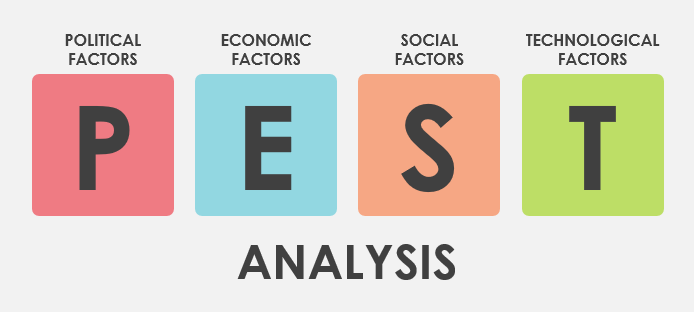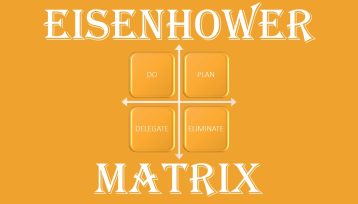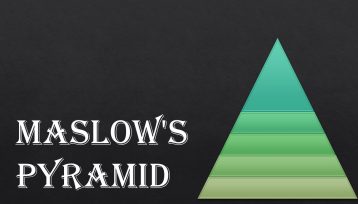Following Mission and Goals as a Part of Strategic Marketing today I’m gonna describe the next step of the strategic marketing – the environmental analysis.
When you analyze the external environment of the company, you have to consider the current state and development prospects of the most important factors and environmental objects for the organization.
Among them it is worth to mention the following:
- Industries
- Markets
- Suppliers
- Competitors
- Political environment
Analysis of the external environment is aimed at identifying changes, trends, opportunities and threats. One of the most common and successful tools for external analysis is PEST analysis.
PEST analysis (sometimes referred to as STEP) is a marketing tool designed to identify the political (P), economic (E), social (S) and technological (T) aspects of the external environment that affect the company’s business. The political aspects must be studied in consequence of the fact that it regulates the authorities that determine the organization’s environment, including obtaining key resources for its functioning.

You need to study the economic aspects due to the fact that it is responsible for the allocation of resources at the state level. The social aspect is considered in terms of determining consumer preferences. The technological aspect is studied in order to identify trends in technology and their development.
There is another type of PEST analysis, the so-called PESTLE analysis. PESTLE analysis is an enhanced with two factors (Legal and Environmental) version of PEST analysis. Sometimes other formats are used, for example, SLEPT analysis (plus the legal factor) or STEEPLE analysis: socio-demographic, technological, economic, environmental, political, legal, and ethnic factors. The geographical factor may also be taken into account.
The results of the PEST analysis should be presented in the form of a matrix. There you assign certain weight to each of the factors. They allow to assess the external economic situation.
Another valuable tool in analyzing the external environment of the company is the methodology developed by the American economist, Professor of Business Administration at Harvard Business School, Michael Porter. This technique was developed and described in 1979.
The model of the five forces applies to all industries, since it covers relationships that are fundamental to any commercial activity: between buyers and sellers; sellers and suppliers; competing sellers; supply and demand.
The methodology identifies five forces that determine the level of competition, and, consequently, the attractiveness of doing business in a particular industry. Porter’s five forces include:
- Threat of substitute products
- Threat of new entrants
- Bargaining power of suppliers
- Bargaining power of buyers
- Rivalry among existing competitors
Let us examine each of the five forces separately.
Threat of substitute products
Based on the model of M. Porter, substitute products have an impact on the competitive situation in the industry. There are companies whose activities are carried out in other industries that produce completely different products. And the consumer can consider them as a replacement for the company’s products.
In this case we are talking about competitive pressure. It influences pricing. Provided that the substitute products are cheaper and consumers agree to use them. Then there is a need to reduce prices, which puts the company in a rather unpleasant situation.

Thus, the following key factors can be identified:
- consumer propensity to purchase substitute products
- comparison of the price and quality of products-substitutes
- cost of switching to a substitute product for the consumer
Threat of new entrants
According to the model of M. Porter, the pressure from the new competitors that enter the same market depends on the existing barriers, as well as on the actions of the players in this market.
There are the following entry barriers to new markets:
- entry barriers (licenses, patents, copyrights, etc.)
- need for product differentiation costs
- brand value
- switching costs or non-refundable (recessed) costs
- starting costs for new players
- access to distribution
- cost advantage
- advantages in position on the knowledge acquisition curve
- expected response actions of old players
- reaction of the government and / or other market regulators

Bargaining power of suppliers
The power of supplier companies primarily depends on the nature of the materials market, on the existing choice, as well as on the amount of costs in terminating cooperation. With a large selection of similar products, suppliers have minimal power in the market.
Suppliers are also limited in power when their consumer belongs to the unique industry. Thus, their existence depends on the success of companies in this market. In the case when suppliers offer unique products, and switching to an alternative is either impossible or associated with very high costs, suppliers have a very large market power.
In this case the suppliers have power over the consumers and set their prices. Key factors of power of suppliers:
- comparison of the cost of switching suppliers and the cost of switching companies
- degree of differentiation of raw materials
- availability of supplier substitutes
- comparison of supplier concentration and company concentration
- comparison of the cost of raw materials and the selling price of the company’s product
Bargaining power of buyers
Buyers are endowed with very large market power. In most cases they are well aware of the prices, characteristics, quality and other attributes of products. Buyers’ power is growing with the growth of substitute products on the market.
Key factors of bargaining power of buyers:
- buyer concentration to the level of company concentration
- degree of dependence on existing distribution channels
- number of buyers
- comparison of customer switching costs and company switching costs
- availability of information for buyers
- availability of existing substitute products
- price sensitivity of buyers
- product uniqueness
Rivalry among existing competitors
With the exception of monopolistic markets, competition exists in any of the industries. In some cases, struggle is weakly expressed, but sometimes the competition is intensified. Here are some cases:
- The presence of a large number of competitors or their approximate equality in terms of size and strength
- Slow growth of the industry, exacerbating the struggle for market share
- The product or service lacks differentiation or switching costs. Fixed costs are high or products are perishable, encouraging lower prices
- Significant growth in production capacity leading to overproduction and lower prices
- Exit barriers are high enough
- Competitors have different strategies and their “individuality.” They are constantly ahead of each other in the process of competition, adhere to various ideologies of competition.
The technique developed by Michael Porter has one key message: in order to lead the market and confront the competitive forces described, you need to develop a strategy that confronts all five competitive forces. This will not only protect the company from competitors, but also ensure a reliable competitive position in the market.
When developing this model, M. Porter emphasized that out of five competitive forces in the industry, only one factor dominates, which determines the organization’s strategy. It is worth paying attention to the factor on which the organization can influence in order to change it.




